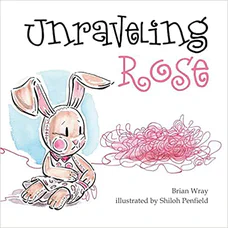Unraveling Rose

Recommended Age Range: Preschool through 2nd grade.
Publisher's Summary:
Rose is a stuffed bunny who loves the little boy she lives with and all the fun they have together. They play in the park, paint pictures, and read stories. Everything is perfect, until she discovers a loose thread dangling from her arm. Rose tries to ignore the little string, but it is no use. No matter how hard she tries, Rose can’t stop pulling at it. Before long, the thread is all she can think about. Slowly, her arm unravels, its stuffing falls out, and Rose can no longer do the things she loves doing. Can Rose find a way to forget about the little loose thread? The story offers a great way for parents and teachers to talk to children about what happens when impulsive and obsessive thoughts get in the way of enjoying everyday life, and what to do about it.

Dr. Annie's Takeaways
Recommended for: This book is a good introduction to the idea that picking/pulling at an “imperfection” (in this book, a loose thread) often makes it worse, and the more one picks/pulls, the harder it is to stop. The book ends with Rose (the stuffed bunny protagonist) realizing that instead of trying to fix her imperfection, she can practice tolerating it until she no longer notices it much at all. It’s a good fit for a child who is struggling to stop picking at imperfections in their skin, hair, or nails to the point that they’re causing sores or bald patches. It could also potentially be used to start a conversation about intrusive thoughts and/or “not just right” thoughts in OCD, but an adult would need to facilitate a child’s understanding of this metaphor.
Would a child like it? Despite its happy ending, the middle is quite sad, and it touches on Rose feeling embarrassed about her picking. Some children might not be ready for the feelings this book brings up. For a child who relates to Rose, however, this book might be validating and hopeful.
Evidence-Based Practices:
Exposure and Response Prevention (ERP)
Tone: Emotionally-resonant; quite sad in the middle with a happy resolution
Story Quality: This story really tugged at my heartstrings. There’s something about a beloved, devoted toy with feelings that gets me. This story beautifully portrays the strong feelings that can accompany body-focused repetitive behaviors (e.g., skin-picking, hair-pulling; also called excoriation disorder and trichotillomania), including a very sad scene when Rose can no longer use her arm because all of the stuffing has fallen out. It ultimately ends happily with a nod to a treatment strategy.
Illustrations: Sweet watercolor illustrations with a lot of white space.
Representation: Rose is a female stuffed bunny. She belongs to a little boy who is White.
Psychological Practices: This book is a great, empathetic introduction to a discussion about body-focused repetitive behaviors (e.g., skin-picking, hair pulling) that children are struggling to stop. When Rose initially notices the loose thread, she tries to ignore it, but despite her efforts, “that loose thread was all she could think about.” She tries pulling on the thread a little, but that makes things worse; now there is a small hole in her arm. Despite her efforts to leave the thread alone, she can’t stop pulling on it until the hole. She tries to hide the hole and the string: “She was embarrassed by what she was doing.” Eventually so much stuffing has fallen out of her arm that she is no longer able to use it, and she starts turning down her little boy’s requests to play and read together. At this dark moment, Rose gathers the courage to make a change. She stitches herself back together and begins to practice ignoring the loose thread: “With practice, Rose forgot the thread was there. The more she didn’t pull on the string, the more she didn’t have to pull…the more she understood that things don’t always have to be perfect.” The book doesn’t go into any more detail than this, but it’s an introduction to the idea that with practice, it will get easier to ignore the thread (whatever that may represent for a child–nail-picking, skin-picking, hair-pulling, etc.). The publisher’s summary suggests that this book could also be used to address obsessive thoughts. An adult would certainly have to make this connection for a child, but the book could potentially also be used as a metaphor for an intrusive or “not just right” thought. The metaphor would be: the more a child tries to “fix” their thought or makes things “just right,” the bigger a problem the thought becomes, and if a child is able to get used to the “loose thread”/ intrusive thought/ not just right situation rather than trying to make it go away or feel right, the thought will stop getting in the way so much!
Concerns: None
